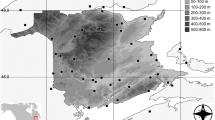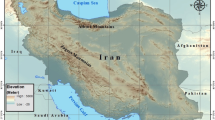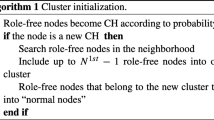Abstract
Changes in climate as projected by state-of-the-art climate models are likely to result in novel combinations of climate and topo-edaphic factors that will have substantial impacts on the distribution and persistence of natural vegetation and animal species. We have used multivariate techniques to quantify some of these changes; the method employed was the Multivariate Spatio-Temporal Clustering (MSTC) algorithm. We used the MSTC to quantitatively define ecoregions for the People’s Republic of China for historical and projected future climates. Using the Köppen–Trewartha classification system we were able to quantify some of the temperature and precipitation relationships of the ecoregions. We then tested the hypothesis that impacts to environments will be lower for ecoregions that retain their approximate geographic locations. Our results showed that climate in 2050, as projected from anthropogenic forcings using the Hadley Centre HadCM3 general circulation model, were sufficient to create novel environmental conditions even where ecoregions remained spatially stable; cluster number was found to be of paramount importance in detecting novelty. Continental-scale analyses are generally able to locate potentially static ecoregions but they may be insufficient to define the position of those reserves at a grid cell-by-grid cell basis.
Similar content being viewed by others
References
Bailey RG (1996) Ecosystem geography. Springer, New York
Baker BB, Moseley RK (2007) Advancing treeline and retreating glaciers: implications for conservation in Yunnan, P.R. China. Arct Antarct Alp Res 39:200–209
Box EO (1981) Macroclimate and plant forms: an introduction to predictive modeling in phytogeography. Dr. W. Junk Publishers, The Hague
Chang DHS (1981) The vegetation zonation of the Tibetan Plateau. Mt Res Dev 1:29–48
Chang DHS (1983) The Tibetan Plateau in relation to the vegetation of China. Ann Mo Bot Gard 70:564–570
Chen X, Zhang X-S, Li B-L (2003) The possible response of life zones in China under global climate change. Glob Planet Change 38:327–337
Coulston JW, Riitters KH (2005) Preserving biodiversity under current and future climates: a case study. Glob Ecol Biogeogr 14:31–38
Cubash U, Meehl GA, Boer GJ, Stouffer RJ, Dix M, Noda CA, Senior CA, Raper S, Yap KS (2001) Projections of future change. In: Houghton JT, Ding Y, Griggs DJ, Noguer M, van der Linden PJ, Dai X, Maskell K, Johnson CA (eds) Climate Change 2001: the scientific basis. Contribution of working group I to the third assessment report of the Intergovernmental Panel on Climate Change (IPCC). Cambridge University Press, Cambridge
Daly C, Neilson RP, Phillips DL (1994) A statistical-topographic model for mapping climatological precipitation over mountainous terrain. J Appl Meteorol 33:140–158
Daly C, Gibson WP, Taylor GH, Johnson GL, Pasteris P (2002) A knowledge-based approach to the statistical mapping of climate. Clim Res 22:99–113
Diaz HF, Eischeid JK (2007) Disappearing “alpine tundra” Köppen climatic type in the western United States. Geophys Res Lett 34:L18707. doi:10.1029/2007GL031253
Diaz HF, Eischeid JK, Duncan C, Bradley RS (2003) Variability of freezing levels, melting season indicators, and snow cover for selected high-evelation and continental regions in the last 50 years. Clim Change 59:33–52
Estivill-Castro V, Yang J (2004) Fast and robust general purpose clustering algorithms. Data Min Knowl Disc 8:127–150
Fang J-Y, Yoda K (1989) Climate and vegetation in China II. Distribution of main vegetation types and thermal climate. Ecol Res V4:71–83
Fraedrich K, Gerstengarbe FW, Werner PC (2001) Climate shifts during the last century. Clim Change 50:405–417
Gnanadesikan A, Stouffer RJ (2006) Diagnosing atmosphere–ocean general circulation model errors relevant to the terrestrial biosphere using the Köppen climate classification. Geophys Res Lett 33:L22701. doi:10.1029/2006GL028098
Gordon C, Cooper C, Senior CA, Banks H, Gregory JM, Johns TC, Mitchell JFB, Wood RA (2000) The simulation of SST, sea ice extents and ocean heat transports in a version of the Hadley Centre coupled model without flux adjustments. Clim Dyn 16:147–168
Gou X, Chen F, Jacoby G, Cook E, Yang M, Peng J, Zhang Y (2007) Rapid tree growth with respect to the last 400 years in response to climate warming, northeastern Tibetan Plateau. Int J Climatol 27:1497–1503
Gu Z, Chen J, Shi P, Xu M (2007) Correlation analysis of Normalized Different Vegetation Index (NDVI) difference series and climate variables in the Xilingole steppe, China from 1983 to 1999. Front Biol China 2:218–228
Guetter PJ, Kutzbach JE (1990) A modified Köppen classification applied to model simulations of glacial and interglacial climates. Clim Change 16:193–215
Hargrove WW, Hoffman FM (1999) Using multivariate clustering to characterize ecoregion borders. Comput Sci Eng 1:18–25
Hargrove WW, Hoffman FM (2004) Potential of multivariate quantitative methods for delineation and visualization of ecoregions. Environ Manage 34:S39–S60
Hartigan JA (1975) Clustering algorithms. Wiley, New York
He HS, Hao Z, Mladenoff DJ, Shao G, Hu Y, Chang Y (2005) Simulating forest ecosystem response to climate warming incorporating spatial effects in north-eastern China. J Biogeogr 32:2043–2056
Hobbs RJ, Arico S, Aronson J, Baron JS, Bridgewater P, Cramer VA, Epstein PR, Ewel JJ, Klink CA, Lugo AE, Norton D, Ojima D, Richardson DM, Sanderson EW, Valladares F, Vila M, Zamora R, Zobel M (2006) Novel ecosystems: theoretical and management aspects of the new ecological world order. Glob Ecol Biogeogr 15:1–7
Hoffman FM, Hargrove Jr WW, Erickson DJ III, Oglesby RJ (2005) Using clustered climate regime to analyze and compare predictions from fully coupled general circulation models. Earth Interact 9:1–27
Jin ZZ, Ou XK (2000) Jinshajiang vegetation of dry-hot valleys, Yunnan and Sichuan. In: Jin ZZ, Ou XK (eds) Yuanjiang, Nujiang, Jinshajiang, Lancangjiang vegetation of dry-hot valley. Yunnan University Press and Yunnan Science & Technology Press, Kunming
Kalvová J, Halenka T, Bezpalcová K, Nemešová I (2003) Köppen climate types in observed and simulated climates. Stud Geophys Geod 47:185–202
Köppen W (1931) Grundriss der Kilmakunde. Walter de Gruyter, Berlin
Köppen W (ed) (1936) Das Geographische System der Klimate. Gerbrüder Bonträger, Berlin
Kottek M, Grieser J, Beck C, Rudolf B, Rubel F (2006) World map of the Köppen–Geiger climate classification updated. Meteorol Z 15:259–263
Leng W, He HS, Bu R, Dai L, Hu Y, Wang X (2008) Predicting the distributions of suitable habitat for three larch species under climate warming in Northeastern China. For Ecol Manage 254:420–428
Liu JY, Zhuang DF, Luo D, Xiao X (2003) Land-cover classification of China: integrated analysis of AVHRR imagery and geophysical data. Int J Remote Sens 24:2485–2500
Liu R, Liang S, Liu J, Zhuang D (2006) Continuous tree distribution in China: a comparison of two estimates from moderate-resolution imaging spectroradiometer and Landsat data. J Geophys Res 111. doi:10.1029/2005JD006039
Lugo AE, Brown SL, Dodson R, Smith TS, Shugart HH (1999) The Holdridge life zones of the conterminous United States in relation to ecosystem mapping. J Biogeogr 26:1025–1038
Metzger MJ, Bunce RGH, Jongman RHG, Mucher CA, Watkins JW (2005) A climatic stratification of the environment of Europe. Glob Ecol Biogeogr 14:549–563
Mitchell TD, Carter TR, Jones PD, Hulme M, New M (2004) A comprehensive set of high-resolution grids of monthly climate for Europe and the globe: the observed record (1901–2000) and 16 scenarios (2001–2100) Working Paper 55. Tyndall Centre for Climate, Norwich
Morgan JA, Milchunas DG, LeCain DR, West M, Mosier AR (2007) Carbon dioxide enrichment alters plant community structure and accelerates shrub growth in the shortgrass steppe. Proc Natl Acad Sci 104:14724–14729
Nakićenović N, Swart R (eds) (2000) Emissions scenarios special report of the Intergovernmental Panel on Climate Change. Cambridge University Press, Cambridge
Neilson RP (1995) A model for predicting continental-scale vegetation distribution and water balance. Ecol Appl 5:362–385
Ohlemüller R, Gritti ES, Sykes MT, Thomas CD (2006) Towards European climate risk surfaces: the extent and distribution of analogous and non-analogous climates 1931–2100. Glob Ecol Biogeogr 15:395–405
Omernik JM (1995) Ecoregions: a spatial framework for environmental management. In: Davis W, Simon TP (eds) Biological assessment and criteria: tools for water resource planning and decision making. Publishing, Boca Raton
Pope VD, Gallani ML, Rowntree PR, Stratton RA (2000) The impact of new physical parameterizations in the Hadley Centre climate model—HadCM3. Clim Dyn 16:123–146
Prentice KC (1990) Bioclimatic distribution of vegetation for general circulation model studies. J Geophys Res 95:11811–11830
Prentice IC, Cramer W, Harrison SP, Leemans R, Monserud RA, Solomon AM (1992) A global biome model based on plant physiology and dominance, soil properties and climate. J Biogeogr 19:117–134
Ricciardi A (2007) Are modern biological invasions an unprecedented form of global change? Conserv Biol 21:329–336
Saxon E, Baker B, Hargrove W, Hoffman F, Zganjar C (2005) Mapping environments at risk under different global climate change scenarios. Ecol Lett 8:53–60
Shaver GR, Canadell J, Chapin FS, Gurevitch J, Harte J, Henry G, Ineson P, Jonasson S, Melillo J, Pitelka L, Rustad L (2000) Global warming and terrestrial ecosystems: a conceptual framework for analysis. Bioscience 50:871–882
Shi XZ, Yu DS, Warner ED, Pan XZ, Peterson GW, Gong ZG, Weindorf DC (2004) Soil database of 1:1,000,000 digital soil survey and reference system of the Chinese genetic soil classification system. Soil Surv Horiz 45:129–136
Song M, Zhou C, Hua O (2004) Distribution of dominant tree species on the Tibetan Plateau under current and future climate scenarios. Mt Res Dev 24:166–173
Song M, Zhou C, Hua O (2005) Simulated distribution of vegetation types in response to climate change on the Tibetan Plateau. J Veg Sci 16:341–350
Trewartha GT, Horn LH (1980) An introduction to climate. McGraw-Hill, New York
U. S. Geological Survey (1996) GTOPO3. http://edc.usgs.gov/products/elevation/gtopo30/gtopo30.html. Cited 15 July 2005
Wang S, Gong D (2000) Enhancement of the warming trend in China. Geophys Res Lett 27:2581–2584
Wang M, Overland JE (2005) Detecting arctic climate change using Köppen climate classification. Clim Change 67:43–62
Wang A, Price DT (2007) Estimating global distribution of boreal, temperate, and tropical tree plant functional types using clustering techniques. J Geophys Res 112:G01024. doi:10.1029/2006JG000252
Washington WM, Weatherly JW, Meehl GA, Semtner AJ Jr, Bettge TW, Craig AP, Strand WG Jr, Arblaster JM, Wayland VB, James R, Zhang Y (2000) Parallel climate model (PCM) control and transient simulations. Clim Dyn 16:755–774
Weltzin JF, Loik ME, Schwinning S, Williams DG, Fay PA, Haddad BM, Harte J, Huxman TE, Knapp AK, Lin G, Pockman WT, Shaw MR, Small EE, Smith MD, Smith SD, Tissue DT, Zak JC (2003) Assessing the response of terrestrial ecosystems to potential changes in precipitation. Bioscience 53:941–952
Williams JW, Jackson ST (2007) Novel climates, no-analog communities, and ecological surprises. Front Ecol Environ 5:475–482
Williams JW, Jackson ST, Kutzbach JE (2007) Projected distributions of novel and disappearing climates by 2100 AD. PNAS 104:5738–5742
Woodward FI (1987) Climate and plant distribution. Cambridge University Press, Cambridge
Yong SC, Feoli E (1991) A numerical phytoclimatic classification of China. Int J Biometeorol 35:76–87
Author information
Authors and Affiliations
Corresponding author
Rights and permissions
About this article
Cite this article
Baker, B., Diaz, H., Hargrove, W. et al. Use of the Köppen–Trewartha climate classification to evaluate climatic refugia in statistically derived ecoregions for the People’s Republic of China. Climatic Change 98, 113–131 (2010). https://doi.org/10.1007/s10584-009-9622-2
Received:
Accepted:
Published:
Issue Date:
DOI: https://doi.org/10.1007/s10584-009-9622-2




